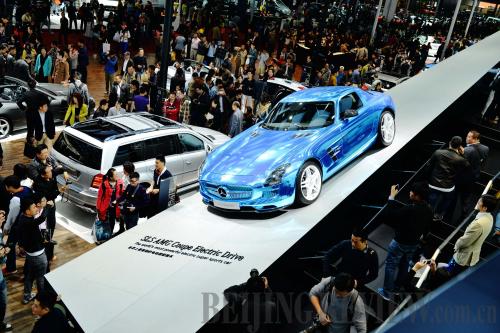|
 |
|
FANCY CARS: Auto lovers view a Benz at the 2013 Shanghai International Auto Show on April 22. Over 2,000 domestic and foreign auto makers participated in the show, which attracted 813,000 visitors (CFP) |
After having lived in France for four years, Jiang Jianlong developed a propensity for luxury goods.
"My favorite brands include Lanvin, Prada, Dolce&Gabbana and Armani," said Jiang, a 31-year-old private equity analyst in Beijing. "I buy luxury products for two reasons. First, they are of better quality and have classic designs. Second, what the brands represent makes it easier for me to mingle with my business partners, who bear a similar mindset toward luxury," Jiang said.
Jiang purchases high-end clothes, watches and scarves. But the thirst for luxury in China extends to bigger toys like premium cars, yachts and private jets. With its newfound and growing wealth, an appetite for all things luxurious is the rage in the country.
A big market
Chinese shoppers have outstripped their U.S. counterparts as the world's top spenders on luxury goods, according to the Luxury Goods China Market Study by Bain & Co., a leading global business consulting firm. About 25 percent of luxury purchases globally are now made by Chinese shoppers, versus the 20 percent by U.S. shoppers, according to Bain.
Chinese shoppers have become a core segment of the luxury market. A weaker Euro and better prices have pushed them to make 60 percent of their total luxury purchases abroad, according to Bain's latest data. While luxury sales in the Greater China region cooled to 6 percent in 2012, top brands continue to outperform. The Greater China region has bypassed Japan as the sector's second market, only behind the United States, said the company. Among Chinese shoppers, Louis Vuitton, Chanel and Gucci are the most sought out, according to the Bain survey of over 4,600 consumers.
"The Chinese consumer has increasingly become a global consumer for luxury brands," said Bruno Lannes, a Bain partner in the Greater China region. "Changes in what Chinese shoppers want are now a central issue for the global luxury sector's largest brands."
China has a soaring luxury market at home. Even in 2009, when the financial crisis rattled the world, the sales volume of luxury products in the country saw a 16-percent year-on-year growth, said Xiong Xunlin, Deputy Secretary General of the China Chamber of International Commerce. "Sales volume of luxury products in China is expected to reach $27 billion by 2015, accounting for 20 percent of the global sales and becoming the world's largest luxury market."
The tremendous spending by the Chinese people globally is backed by a growing middle class and an expanding number of rich and wealthy. China had over 1.4 million multimillionaires by the end of 2012. Luxury consumption accounted for 35 percent of their private spending, according to a report released by Fortune Character magazine based in Shanghai.
"China has a rising number of rich people with strong consumption ability and desire. That's why the country's luxury market outperformed others amid a sluggish global economy, and why globally renowned luxury brands cashed in on the market," said Zhou Ting, head of the research institution.
Max Magni, head of McKinsey & Co. consumer practice in the Greater China region, said that the growing middle class will be a pillar of future luxury consumption in the nation.
"A growing middle class in the country, with an annual disposable household income of between 50,000 yuan ($8,110) to 250,000 yuan ($40,550), will become the new buyers of luxury products. In the coming three years, over 40 billion yuan ($6.49 billion) will be spent on luxury consumption from those Chinese," said Magni.
What do they buy?
Private jets are favored by China's super rich. Back in 2011, famous Chinese comedian Zhao Benshan made headlines when he purchased a private jet worth 200 million yuan ($32.44 million). The Chinese mainland led the Asia-Pacific region in possessing 187 business aircraft in 2012, up 103 percent from a decade ago, according to market researcher JetNet.
|
